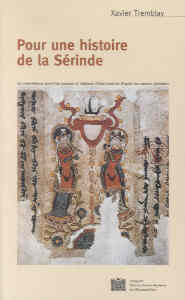|
 |
Le présent ouvrage s'adresse à trois publics: l'historien des religions et le théologien y trouveront la première histoire du Manichéisme en Asie Centrale, avec une étude de son milieu, de son rôle politique et de ses attitudes théologiques et éthiques, ainsi qu'une liste de tous les fragments manichéens et chrétiens classés d'après le texte auquel ils appartenaient. Ce livre est aussi un ouvrage de référence indispensable pour le philologue en raison de la bibliographie commentée des 32 langues attestées dans les documents de Haute Asie. Il souhaite enfin combler le vide entre les esquisses historiques qui répètent sans critique ni renvoi aux sources des affirmations de seconde main et les éditions de sources primaires et ainsi offrir à l'historien ou à quiconque s'intéresse à la Route de la Soie une réflexion documentée. …
The Silk Road has become world-famous among esthets for the wall-paintings of Tun-Huang and Afrasyab or the Bamyan Buddhas, and among philologists for the Old Turkic inscriptions or the Tocharian and Middle Iranian Manuscripts. But disappointingly few scholars have tried to make chronological, social and geographical distinctions among and between the communities and peoples who created these extremely diverse literatures and arts. The present book is an attempt to fill the gap between historical sketches in which the assumptions of Chinese or Arab annalists or of scholars from the dawn of the XXth Century are repeated uncritically and without even a reference to the sources, and the editions of primary material, which reach the historical implications at best incidentally. Hence there is a close association between the philological assessment and investigation of the sources and their historical interpretation. The philological side of the work is represented by the dialectal and chronological classification of the Sogdian, Tocharian and Old Turkic manuscripts based on palaeographic and linguistic criteria, the critical bibliography of the 32 languages from Serindia (from Greek or Hebrew to Chinese via well-known pals such as Zhang-zhung or Bactrian) or the list of all published Manichaean and Christian fragments classified according to the text to which they belonged. The present book is, however, also the first published history of Central Asiatic Manichaeism to study the circles from which the Manichaeans came, the political role they took and the theological and ethical attitudes they adopted.
|



 Home
Home
 Print
Print
 References
References
 Share
Share